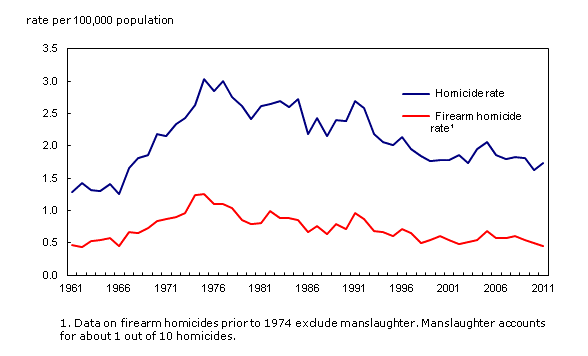Homicide in Canada, 2011
Archived Content
Information identified as archived is provided for reference, research or recordkeeping purposes. It is not subject to the Government of Canada Web Standards and has not been altered or updated since it was archived. Please "contact us" to request a format other than those available.
Related subjects
-
[an error occurred while processing this directive]
Police reported 598 homicides in Canada in 2011, 44 more than the year before. This was the first increase in homicides in three years.
The homicide rate was 1.73 per 100,000 population in 2011, 7% higher than the previous year. Despite annual fluctuations, the homicide rate has remained relatively stable over the past decade. Previous to this, it had generally been declining since the mid-1970s.
Homicide and firearm homicide rates, 1961 to 2011

Chart description: Homicide and firearm homicide rates, 1961 to 2011
Most of the increase in 2011 was accounted for by two provinces: Alberta, which had 32 additional homicides, and Quebec, which had 21 more. The homicide rate in Ontario, which had 28 fewer homicides compared with 2010, reached its lowest point since 1966.
Among the provinces, Manitoba reported the highest homicide rate for the fifth year in a row, followed by Saskatchewan and Alberta.
The census metropolitan area (CMA) of Winnipeg, where police reported 39 homicides in 2011, had the highest rate among Canada's CMAs, followed by Halifax and Edmonton. Homicide rates in Winnipeg and Halifax were the highest recorded in those CMAs since data became available for CMAs in 1981.
Lowest rate of firearm homicides in almost 50 years
In 2011, 158 homicides were committed with a firearm, 13 fewer than the previous year. The rate of firearm homicides per 100,000 population has generally been declining since the mid-1970s and, in 2011, reached its lowest point in almost 50 years.
The rate of homicides committed with a handgun has also generally been declining since reaching a peak in 1991. Handguns continue to account for about two-thirds of all firearms used to commit homicide.
An increase in stabbings accounted for virtually the entire increase in homicides in 2011. There were 39 more stabbings in 2011 than in 2010. Overall, stabbings accounted for 35% of homicides, firearms for 27%, beatings for 22% and strangulation for 7%.
Gang-related homicides unchanged in 2011
Police considered 95 homicides to be gang-related in 2011, similar to 2010, but well below the peak of 138 reached in 2008. Gang-related homicides increased steadily from the early 1990s until 2008, before declining in both 2009 and 2010.
Manitoba, Saskatchewan and Alberta reported the highest rates of gang-related homicides among the provinces in 2011. Winnipeg, Saskatoon and Edmonton reported the highest rates among the CMAs.
Most homicide victims and those accused of homicide are male
The majority of homicide victims and those accused of homicide are male. In 2011, males accounted for 7 in 10 homicide victims and 9 in 10 persons accused of committing homicide.
Homicide victims typically know their killer. Among solved homicides in 2011, almost half (48%) were killed by an acquaintance or friend, one-third (33%) by a family member and 15% by a stranger.
Intimate partner homicides stable in recent years
Police reported 89 homicides involving intimate partners in 2011, including 76 female victims and 13 male victims. This resulted in a rate of 0.26 intimate partner homicides per 100,000 population, similar to the rate in recent years.
Of all intimate partner homicides in 2011, 36% of victims and accused were married, 36% were in a common-law relationship, 26% were in a dating or other intimate relationship and 2% were in a same-sex relationship. These categories include persons in both current and former relationships.
The rate of intimate partner homicides committed against females increased by 19% in 2011, the third increase in four years. However, the rate for male victims declined by almost 50%, reaching its lowest point since data collection began in 1961.
Available without charge in CANSIM: tables CANSIM table253-0001 to 253-0007.
Definitions, data sources and methods: survey number survey number3315.
The Juristat article "Homicide in Canada, 2011" (Catalogue number85-002-X, free) is now available. From the Key resource module of our website under Publications, choose All subjects, then Crime and justice, and Juristat.
For more information, or to enquire about the concepts, methods or data quality of this release, contact us (toll-free 1-800-263-1136; infostats@statcan.gc.ca) or Media Relations (613-951-4636; statcan.mediahotline-ligneinfomedias.statcan@canada.ca).
- Date modified:
